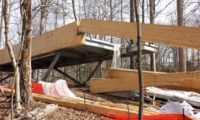Hyundai Engineering and Construction Co. (HDEC) and the Chilean government have dismissed reports of construction of the $740-million Chacao Channel Bridge has halted, despite a simmering dispute over compensation for the project’s rising costs.
HDEC, with consortium partners Systra and Aas-Jakobsen, is leading design and construction of the 2.75-kilometer bridge that will link the coastal island of Chiloé with the mainland approximately 630 miles south of Santiago, and originally scheduled for completion in 2020. On Dec. 23, the Seoul-based contractor blamed the Chilean government’s “breach of commitments” and “bad faith” negotiations over scope and cost changes for making it “impossible, in these conditions, to continue with the project.”
Just 24 hours later, however, HDEC told Reuters news service that reports of a construction halt were untrue. The same day, Chile’s Public Works Minister Alfredo Moreno said his government would work to keep construction on schedule, despite having rejected the consortium’s request for an additional $300 million to complete the project.
Moreno also pledged to continue efforts to reach an agreement with the consortium, provided it fulfills the priorities of “building this bridge and achieving connectivity with Chiloé,” and meeting deadlines, as well as ensuring that “Chile’s resources are looked after.”
Tensions between the two sides appeared to have eased by Dec. 26, when Korea’s Yonhap News Agency reported an HDEC press release describing talks with the Ministry as “going well over appropriate costs of additional work caused by Chile’s demand for design changes in the project.”
Consisting of three reinforced concrete pylons, with 3,789- and 3,469-ft main spans, the four-lane suspension bridge will be the largest of its kind in Latin America. The 574-ft tall central tower is being erected atop a small reef in the middle of the channel, while the other towers will be founded on land. Along with an active seismic fault just 50 miles away, the structure will also be subject to the strait’s strong current and wind loads.
The bridge has had a bumpy history since it was first proposed in 1972. Along with numerous cost-related false starts, the plan has encountered mixed support among Chile’s population. Many fear that for replacing existing ferry service with a bridge will attract over-development, with logging and mining activity threatening local fisheries.
Even after Chile awarded the current contract in 2013, the project stalled due in large part to the financial woes of the consortium’s original lead partner, OAS of Brazil. Consortium member HDEC subsequently purchased the OAS stake, giving it majority control over the project and allowing construction to get underway in early 2018. Chile’s approval of the bridge’s final design later that year was soon followed by reports of a consortium request for additional funding.
As project costs have mounted, so have delays. Shortly after crews installed the last of the central tower’s 36 piles, in September 2019, the consortium requested extending the completion deadline to 2025.



Post a comment to this article
Report Abusive Comment